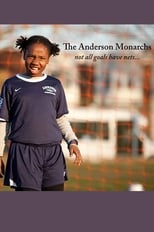Soccer decision makers, fans, and parents who don’t understand how our sport works in America should watch The Anderson Monarchs. Writer-Director Eugene Martin captures, in a decidedly upbeat way, the commitment required to sustain a unique, inner city, all-African-American, girls soccer team in Philadelphia.
Even though Martin first started filming in 2009, the pay-to-play situation in American soccer has not changed much in the 10 years hence, especially for women.
The power of play and positive role models
Like many inner city programs, the Anderson Monarchs soccer club survives on dedicated boot strapped volunteerism, with Coach Walt Stewart (a middle aged White male) providing copious amounts of time, equipment, and enthusiasm. But the benefits can be significant. The film spends quite a bit of screen time with 11-year-old Kahlaa Cannedy and 13-year-old Jlon Flippens, who are both very well-spoken and proud of their accomplishments. They would be a credit to any parent. As of 2018, Kahlaa is enrolled at Swarthmore College, while Jlon plays for University of Maryland.
For the rest of the 30-odd players that Stewart coaches (he has several teams in various age groups), the film shows the power of play and the benefit of positive role models. Former pro Staci Wilson runs a few clinics with the girls and comments that seeing how other teams react to the Monarchs shows whether or not progress is being made for Black women in soccer.
The film also demonstrates the value of team spirit, community, and identity. For example, even though Kahlaa and Jlon get recruited away to club teams, they still return to the Monarchs for winter indoor and, with 4 other girls, they compete in a 3v3 “World Championship” at Disney World in Jan-2010. In a way, being an all-Black team makes all the girls role models to themselves.
Grass roots soccer is hard to sustain
The issue is glanced over, but it is difficult to retain good players in a recreational environment. Being a good player and a good student opens doors to private schools and better teams. When the better players leave, the rec team has to start all over again, training new players.
In the case of Coach Walt Stewart, he started his own club, but I could find no further information about him after 2015. I assume that, as I often saw in CYSA, club teams do not survive unless they have winning records, or they fall apart when a key volunteer becomes ill, burns out, or their child stops playing. Grass roots soccer in America is anything but self-sustaining.
The soccer in the film is very good for showing levels of play at U13. Hopefully, someday these kids will consider themselves fortunate that their tournament travel is portrayed in a feature length documentary.
Weaknesses
There are several weaknesses to the film. In large periods, it tends to be more like a music video, with lots of nice visuals and photography set to soothing music by Mario Grigorov. Scenes are not portrayed chronologically, and context is not provided, so I had to piece together parts of the Monarchs story from news articles. A newsreel about Marian Anderson is included, and the coach reiterates the story of how she was not allowed to perform at Constitution Hall in 1939. A funeral for a Muslim high school girl not on the team is included, perhaps to demonstrate how violence surrounds the neighborhood?
Sports Team of the Year nominee
The Anderson Monarchs teams are part of the Philadelphia Youth Organization, whose mission is to get inner city children off the streets and mentor them towards college. The girls soccer team gained national attention in 2008 when Sports Illustrated writer Michael Bamberger nominated them for Sports Team of the Year in an online essay. Director Martin had actually coached against the Monarchs for several years and got enough funding to start making the film, including a grant from Sundance. The national exposure eventually led to the club’s being invited to the White House for a soccer clinic on the White House lawn as part of Michelle Obama’s Get Up and Move program. About 30 Monarchs participated on October 6, 2011.
Also note that Mo’ne Davis, the first girl to pitch a shut out in the Little League World Series (in 2014), was from the Anderson Monarchs baseball club.
Other all-Black female teams
The film piqued my interest in the number of first all-Black female teams in America. It turns out that surprisingly few such stories have been in the media. They include a girls Chess team, a flight crew, a NASA challenge team, a rodeo team, a college swim team, and most recently, an all-Black womens volleyball team.
I’m very thankful the Kicking + Screening film festival made this film easily accessible to its twitter followers. My feeling is that The Anderson Monarchs has value to young girls of color, as well as their parents. But perhaps USSoccer members could watch this film and be motivated to make soccer development better for all kids in America, so that organizations like the Monarchs are not one-offs.
7 Soccer Movie Mom Rating = 7
Resources:
- Released: 2012-08-17 (USA)
- IMDB
- Director: Eugene Martin
- Stars: Walter Stewart , Jlon Flippens
- Watch the Trailer
- Anderson Monarchs Website

